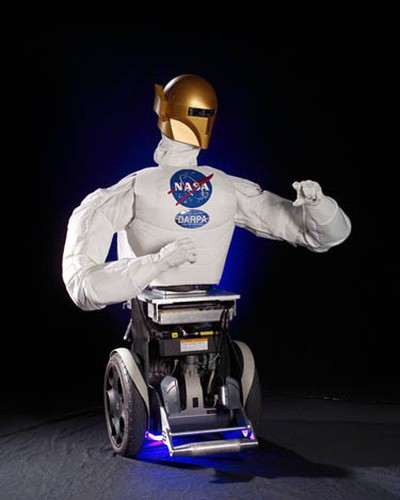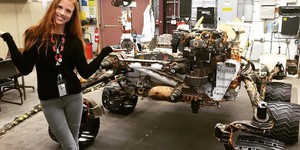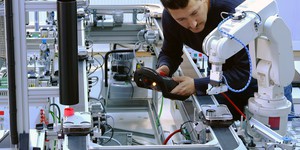Abstract
In the mid-20th century, people thought of robots as futuristic tools. But in the 21st century, robots are not a figment of our imaginations, but are a part of our reality. Robots even perform tasks that humans can't do. In this engineering science fair project, you will use LEGO Mindstorms to build a robot that is fast, lightweight, and stable. Who knows? You might end up building a robot that does housework or even your homework!Summary
Michelle Maranowski, PhD, Science Buddies
This project is based on a DragonflyTV episode.
- LEGO® and Mindstorms® are trademarks of the LEGO Group.

Objective
The goal of this engineering science fair project is to build a fast, lightweight and stable robot using LEGO® Mindstorms®.
Introduction
Have you seen the movie Star Wars? One of the most interesting things about this movie is the variety of robots. There are robots that talk to farming equipment, protocol robots, and even medical robots! But what exactly is and what makes up a robot? The definition of a robot varies, depending on with whom you speak, but in general, a robot has a reprogrammable brain (computer) that controls a body. A robot is made up of a movable physical structure, a power supply, a motor, a sensor, and a computer brain that controls all of these parts.
Robots and robotic parts are moving out of the realm of fantasy and into our everyday lives. They are used on manufacturing lines to build cars and computer chips, and are even used to perform hazardous work that humans cannot do. For example, humans are not yet able to travel to Mars, so NASA has sent Mars rovers to gather data. Robots can even perform some surgeries on humans (with some help from human doctors).
Building a robot to perform tasks, like the ones described above, is complicated. It takes entire teams of engineers and scientists to build robots like the Mars rovers. One team may be responsible for designing the part of the robot that picks things up. Another team may be responsible for the robot's vision. But even before the teams start working on and building their parts of the project, they all need to come together to precisely define the function of the robot and how it will go about accomplishing that function. The team also needs to understand the environment in which the robot will be working. Building a robot requires not only great technical skills, but also great teamwork. Teamwork is always the basis of successful projects. It is also the only way to get big projects done in a short amount of time.
In this engineering science fair project, you and your team will build a robot using a LEGO Mindstorms NXT kit. Click on the link in the Bibliography to watch the DragonflyTV video showing how Sasha, Makeisha, Claire, Hannah, Annice, and Emily go about building their robot. First you'll need to assemble your team. Then, you should all precisely define the function of the robot. For this engineering science fair project, you must build a fast, stable robot whose function is to make a turn with a tight radius (called a turning radius). You'll then become familiar with the Mindstorms software, and build and compare robots with different numbers of wheels to see how that affects stability and speed. Building a functioning robot is hard work, but it is rewarding and fun, too!
 Image Credit: NASA / Public domain
Image Credit: NASA / Public domain
Figure 1. The NASA Robonaut is designed to go into environments where humans can't go, as well as to work alongside humans. (NASA, 2003.)
Terms and Concepts
- Robot
- LEGO Mindstorms
- Turning radius
- Robonaut
Questions
- What is a robot?
- For what different applications are robots used?
- What are the different sensors that come with the LEGO Mindstorms kit? For what are they used?
Bibliography
- Harris, T. (2002, April 16). How Robots Work. Retrieved December 2, 2008.
The following website is NASA's overview on the Robonaut project:
- Bibby, J. and Necessary, R. (2008, March 13). Robonaut. Retrieved December 2, 2008.
This science fair project was based on the following episode from DragonflyTV:
- TPT. (2006). GEMS by Sasha, Makeisha, Claire, Hannah Annice and Emily.DragonflyTV, Twin Cities Public Television. Retrieved December 2, 2008.
For help creating graphs, try this website:
- National Center for Education Statistics, (n.d.). Create a Graph. Retrieved June 25, 2020.
Materials and Equipment
Note: The LEGO Mindstorms product line was discontinued at the end of 2022. However, many Mindstorms kits are still in circulation and you can probably borrow one or purchase a used one. The instructions for this project were written for the LEGO Mindstorms NXT 2.0 kit. You can do this project with an EV3 kit, but the programming software is different. Follow LEGO's online resources to learn how to program your EV3 robot.
- Team members (at least 3), all team members should have access to the Internet and a computer that can run the LEGO Mindstorms software.
- LEGO Mindstorms
- Meterstick
- Masking tape (1 roll)
- Digital timer
- Lab notebook
Experimental Procedure
- To start this science fair project, choose your team members and be sure they are willing to work on this long-term project. Your team members should all be available for the following steps.
- Read the software system requirements to run the LEGO Mindstorms software. Prepare your computer and install the software. Read through the manuals to become familiar with the software.
- Open the rest the Mindstorms kit and become familiar with all of the different sensors. Try to build some of the simple designs found online. This step will take some time for you and your team. Be patient and have fun!
- Develop a robot design using three wheels. The design should be a team effort. Think about what makes an object stable and speedy. Hint: An object that is speedy would most likely have the minimum number of LEGOs possible.
- Find an area where you can safely test your robot. It can be on a wood floor or on carpeting, but make sure it is readily available, because the location you select will be the test area for the rest of the project. Set the meterstick on the ground. Put a piece of masking tape on the floor at the top end of the meterstick. Move the meterstick down one length. Place another piece of masking tape at the bottom end of the meterstick. Remove the meterstick. This is the test course and the pieces of tape mark the start and end of the course. The test course should be approximately 2 meters (m) long.
- Use the Mindstorms software to put together a set of instructions to make the robot move straight.
- Place the robot at the starting line. Turn on the NXT and push the start button. Start timing how long it takes for the three-wheeled robot to make it to the end line. Record this time in your lab notebook.
- Repeat step 7 two additional times.
- Now use the Mindstorms software to put together a set of instructions to make the robot turn around.
- Use the meterstick to measure the turning radius of the robot. This is the radius of the smallest circular turn that the robot can make. Record the data in your lab notebook.
- Repeat step 10 two additional times.
- Now redesign the robot to have four wheels. Try to make small changes to the vehicle, enough to accommodate just the fourth wheel.
- Repeat steps 7–8 and test the new robot design on the same course that you used in step 5. Is there a difference in the time between the three-wheeled robot and the four-wheeled robot? Record all data in your lab notebook.
- Repeat steps 10–11 with the four-wheeled robot. Does one design have a better turning radius than the other? Is one design more stable than the other? Remember to record all data in your lab notebook.
- Plot your data on two scatter plots. For the first plot, label the x-axis Robot and the y-axis Speed. For the second plot, label the x-axis Robot and the y-axis Turning radius. If you need helping plotting your data, or would like to make your plots online, you can use the Create a Graph website. Do you see any trends? Is there a design that is clearly better than the other?
Ask an Expert
Global Connections
The United Nations Sustainable Development Goals (UNSDGs) are a blueprint to achieve a better and more sustainable future for all.
Variations
- Test your robot designs on several different surfaces (i.e. carpeting, concrete, wood, fine gravel). How is the stability of the robot affected by the surface?
- Can you modify your design to do another task, like pulling another object?
Careers
If you like this project, you might enjoy exploring these related careers:











